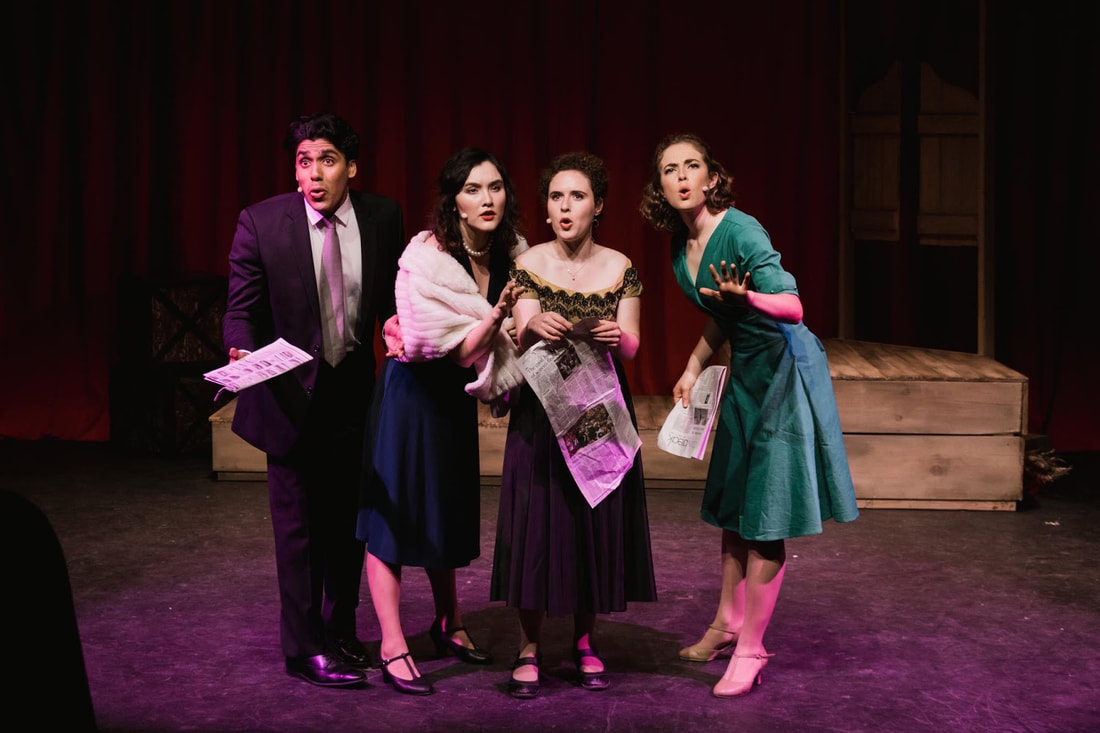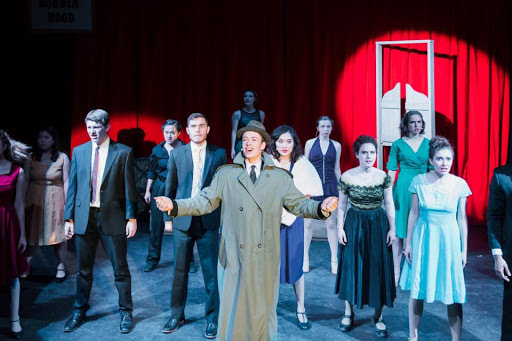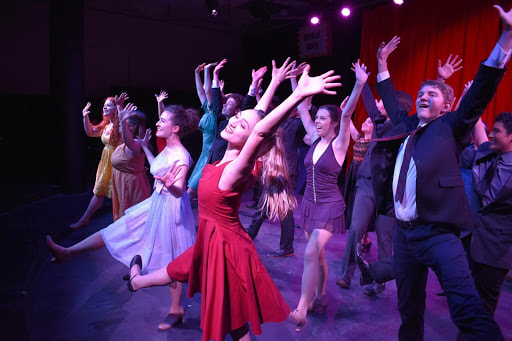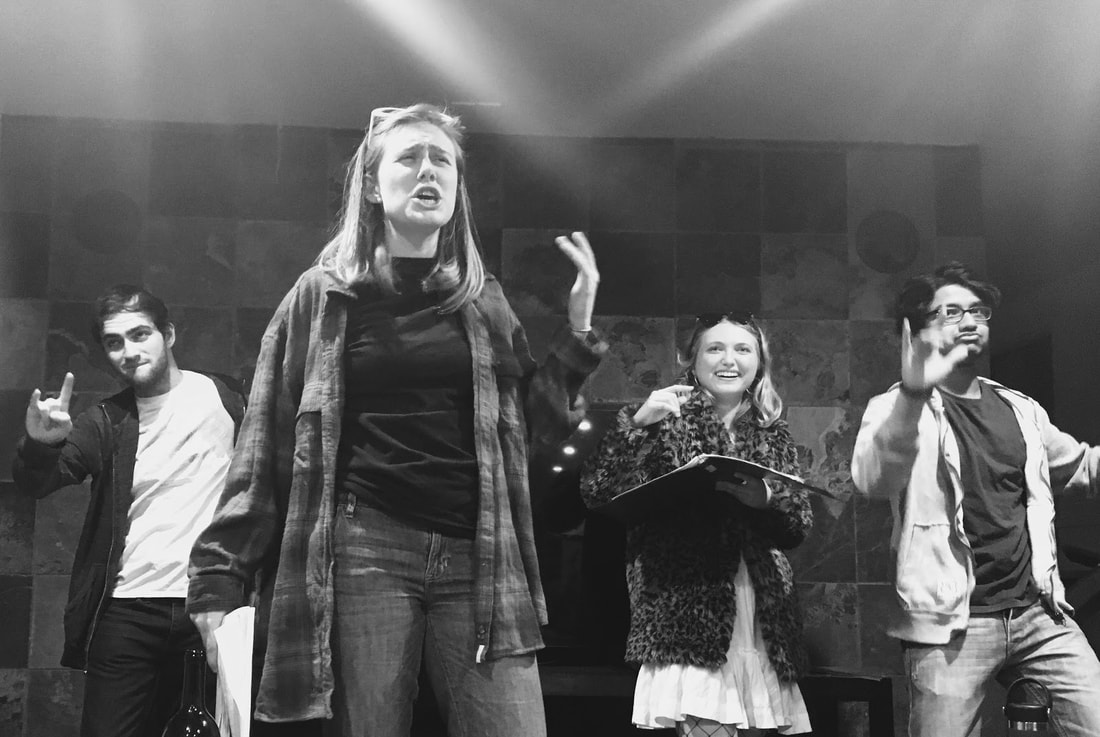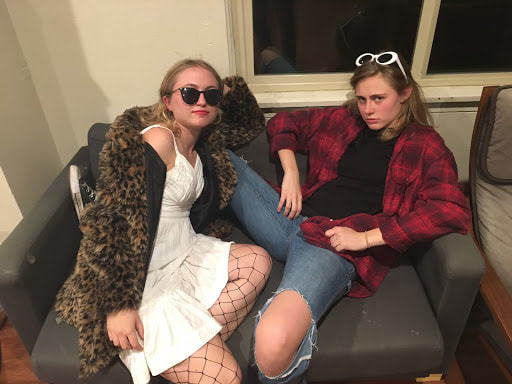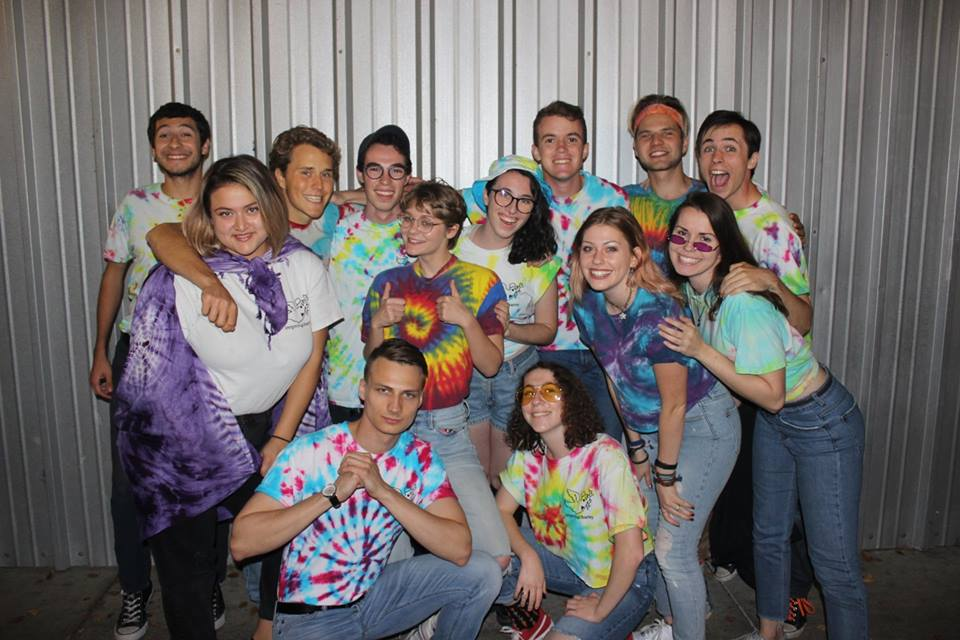|
BareStage Performers in Curtains By Katherine Schloss One of the major theatrical production organizations on campus is BareStage Productions. They pride themselves on providing pre-professional opportunities for students to get involved in every aspect of the theatrical process. I personally watched their production of Cabaret last semester and was impressed by the dark depth of the story that they were able to convey to the audience through their performance and storytelling. I interviewed Eliana Adise, the managing director of BareStage, to get a better feel for the organization in its massive appeal to the student body. When asked about the history of BareStage, Eliana said that, “BareStage was founded in 1994 by Ben Rimalower. It was always intended to be student-run theatre but it has expanded in size and production value since its beginnings. There are many opportunities for students to get involved in BareStage. We put on four productions a year- two plays and two musicals. Students can get involved in any of these four productions as actors, production team, orchestra, designers, and directors. Outside of these productions, students can also get involved in BareTroupe, our musical theatre ensemble, gain technical experience at our Build Days or by shadowing senior members of our company. Finally, students can get involved in our Board of Directors and Company Member positions and gain much of the experience one would typically encounter in running a professional theatre company (on a smaller scale).” This semester, Barestage put on two productions: 1984, an adaptation of George Orwell’s dystopian novel, and Curtains, a comedic murder mystery musical within a musical. Ethan Glasman made his directorial debut for Curtains, and the students had their passionate efforts rewarded when they sold out their second weekend of shows despite having to reschedule due to the poor air quality in Berkeley. As managing director, Eliana oversees the Board of Directors and helps to refine their artistic visions so that they can become a reality. Eliana brings up the fascinating concept of how plays and musicals that were written in a completely different time period can be revived or can be used as a vessel for providing commentary on the current state of things as well as for showing how history can repeat itself. She says, “To me, the magic of live theatre is its inability to be archived. Each performance differs as artists learn and grow and as audiences experience the show for the first time. When we choose our season, every show carries a new message with it; a reflection of the flaws we see in the world, idealization of the world that can be, an escape to the fantastical imaginings of art itself. Several shows we’ve put on recently, Curtains and Noises Off, have been shows within a show. So on one hand, you have this escape from everyday reality and on the other hand, you have an honest reflection of the world artists live in and the work they produce. That’s what I love about theatre. Artists that so willingly bare their soul to comment on society.” In this way, performances within the theater are also so incredibly personal, and though you sit and have an experience with the mass of people that surround you in the audience, each individual also has their own unique take-away from the show and approaches the messages differently based on their own life experiences. BareStage performers in their production of Curtains I also was able to get some perspective from Walker Heintz, who has both acted with Barestage as well as being involved as a dramaturg. He says that what may seem like a grueling amount of rehearsals - 4 hours a day, six days a week - became a positive thing to look forward to at the end of the day. He cites BareStage as being a good place for first timers to express themselves and to “try something new on the stage,” as well as a space for “anyone looking to express their creative side.” He felt that seeing how their art affected the audience was “one of the most rewarding things” that he has done at Berkeley. Experiencing the thrill of being onstage and then being involved in the creative process the next time around gave him a very well-rounded perspective. Of that he said that he found being able to “witness the creative aspects of organizing and fulfilling the creativity of the actors and actresses on the stage” to be a “completely different reward in itself.” He says that BareStage is a tremendous experience for anyone looking for an outlet at a school as big as Berkeley! BareStage performers in Curtains BareStage Performers in 1984
0 Comments
The cast of “A Mid-Nineties Night's Dream” at rehearsal by Katherine Schloss 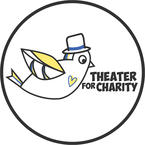 Coming to college, it’s interesting to see the different paths that those of us who dedicated our high school careers to theater take. For some, it means a degree and a pursuit of the bright lights of Broadway. For others, it means finding that theater bleeds into so many other forms of learning, and that we can diversify ourselves from the skills that we gained. I feel that theater often gets written off as cheesy and that theater kids get pushed into a corner where we’re wearing dramatic scarves and doing random interpretive dancing. Truthfully, comedic theater is an art form that reflects the ups and downs of the universal human experience. To dive into the theater scene on Cal’s campus, I interviewed the President of Theater for Charity, Ethan Schlatter. Ethan himself got involved in T4C because he didn’t want to major in theater but still wanted a way to be casually involved in theater at Berk. He said that, “Theater4Charity was founded over 10 years ago as a student organization at Cal. T4C is a 100% student run, acted, written, directed, and acted club. This means that we only put on completely original shows by Cal students. From these shows, we put on usually two showcases a semester and donate 100% of our ticket proceeds to charity and we pick new charities each semester.” Ethan also comments on the universality of theater, saying, “I personally think theater and comedy are so universal because of the sheer escapism of theater. Especially with how constantly connected everyone is, it's great to just sit back and watch something that will make you happy. I also think theater and comedy are so universal because they’re so accessible. You don’t need a camera, crew, or even a dramatic stage or lighting to put on a performance. Comedy can be as simple as just telling jokes with friends.” I feel that comedic theater is a real art and that many do not realize the true extent of planning and life experience that goes into a good joke or bit. To this end Ethan says, “It’s a really great form of self expression, letting the writers, actors, and directors all share something in a wacky and outlandish way that they might not have been able to regularly. It’s also a great way to share ideas with people. You don’t have to be doing a serious drama to broach an important issue. While obviously not all of comedic theater is going to have some underlying message, I feel like a lot of people discredit the ability of comedy to actually say something.” I personally joined T4C this semester and I’ve seen first-hand how students light up when they’re given a space to engage in comedic scenes and bits, such as with our recent one-acts. We’re now moving on to our full-length, “A Mid-Nineties Night’s Dream,” which was written by Brendon Greenberg. It’s a lose comedic biography of Kurt Cobain told in Iambic Pentameter. Proceeds are being donated to the Berkeley Food Collective. When asked where his inspiration for the project came from, Brendon said, “My friend Joe and I went for a night walk through the neighborhood and we were just riffing and joking around and the concept of ‘That 90’s Musical’ came up and I wrote it down in my notes. Then it morphed into ‘A Mid-Nineties Night's Dream’ and I really wanted to write a play around that pun. I was obsessed with Nirvana in highschool and so I already knew a lot of trivia and lyrics that I could incorporate to make a plot. Also, angsty Kurt Cobain as a 90s Hamlet analog, and his controversial romance with Courtney Love a la Romeo and Juliet seemed to fit quite well.” For someone who’s obsessed with music as well as the bard, it’s been such a magical experience to watch Brendon’s smartly-written text come to life. When asked how he combined the ancient art of Shakespeare with more recent forms of comedy, Brendon said, “There are a lot of these tropes like disguise plots and mistaken identities, roundabout wordplay, the rhyming, etc. that kinda lend themselves to humor as it is. The rest, hopefully, comes from the juxtaposition between the antiquated, metered English and the world of the 90’s i.e. ‘Hast thou seen the new vid on MTV’ --you know, at the least it sounds kinda weird.” His writing of the play combined his love for Nirvana with an academic pursuit of English as a minor. “One of my favorite classes was 117s, which surveyed Shakespeare’s career beginning to end. That's where all of my knowledge of Shakespeare and theater comes from, for the most part. From there I just pulled from character archetypes, type scenes, famous monologues and mashed them together with their counterparts in Kurt Cobain’s life, and inserted and adapted music lyrics to make a lot of the dialogue and speeches while counting the syllables as I wrote.” Brendon is in many improv groups on campus, including Improv4Charity. In relating this back to his writing, he says, “In improv a lot of the humor is about being inspired by real people and situations and using those real experiences as a starting point. I'm really amused by fandoms, hardcore sports fans, super pretentious sci fi nerds, diehard EDM people, etc, just the concept of these big cultural phenomenons that have so much gravity and effect on people but they're so niche and kinda ridiculous in a vacuum...I channeled the diehard Nirvana geek I was sophomore year who listened to ONLY Nirvana for like 6 months straight...so I guess I tried to parody this idea of ‘a rock mythos,’ you know they talk about this pantheon of ‘musical gods.’ I guess what I’m trying to say is people worship these people, the Kurt Cobains and Thom Yorkes-the big players in whatever niche community they identify with, and it’s fun to look back and laugh at that sometimes?” Brendon also has some great insight when it comes to seeing art in terms of comedy: “You always see that theater symbol logo thing with the two masks, one frowning for drama and one smiling for comedy...so art and comedy are definitely not mutually exclusive especially for theater, it seems to be at least half of it based on this evidence. A lot of the time art is funny and funny is art, or at least I tend to find humor in art museums and novels and stuff…maybe the safe thing to say is comedy is an approach to art? “For example, a portrait painting can be funny depending on the subject, or at least the way the subject it painted (i.e. an oil painting of some nobleman with a neckbeard and fuzzy fedora hanging in the museum of beaux-arts vs. caricatures of people with super exaggerated features painted by the guy sitting in the park, it’s kind of a stretch, but you get the point). For me, art is about representing the world and how you represent it. You can choose to represent the drama and woes of the world in very poignant forms, or the comedy of the world in way that heightens the ridiculousness, or a mix-match of either, maybe with a tinge of irony.” “A Mid-Nineties Night's Dream” will be performed November 30th and December 1st and 2nd! Come out and support a great cause while also feeling as if you’re in the globe theater with the frontrunner of Nirvana himself. Follow Theater for Charity on Facebook for updates. Left: Katherine Schloss as Courtney Love and Arcadia Eckmayer as Kurt Cobain
Right: Ethan Schlatter, T4C Prez By Katherine Schloss In high school, my theater group was inextricably linked with the improv group, and I avoided my teenage angst by attending the improv shows when I wasn’t performing in productions for theater. I always envied the improvisers, cracking up at their wit and deeming their on-stage choices as “smart” despite the fact that I knew that I couldn’t do so myself. There’s a certain boldness that comes with throwing oneself out onto a stage, when you let down your barriers and allow your body to be a vessel for the promotion of a heightened sense of hilarity.
The more politically aware I became in the days leading up the 2016 presidential election, the more I turned to comedy as a refuge from the ever-changing (and often frustrating) political climate. Not only had it become a coping mechanism, it had also become a way to realize that I wasn’t alone in my feelings of turmoil within a world that already felt unsteady. My love for stand-up comedians such as John Mulaney has become a bit ridiculous, as I begin to idolize them and their ability to turn their own personal experiences into cultivated and relatable bits, just as an artist in the more traditional sense might curate a collection. Improv, however, is a whole other beast. It involves split-second decisions, demanding that the improvisors generate material on the spot and in relation to the decisions of those around them, resulting in a sort of dance in which all of the players feed off of each others’ energies to create a larger masterpiece. Coming to college, I felt that initial drive to try new things and to diversify myself, but for whatever reason I always gravitate back to watching improv shows on Friday nights, quelling my swirling thoughts and allowing myself to give into the satisfying art of improvisation for a few charming hours. One of these groups is improv4charity, which has delivered clever shows with titles such as “Tie-Dye or Die Tying.” I decided to interview Colin Jindra, the president of the club, to gain some further insight on how improv, comedy, and art are all intertwined. Kat: How is improv an art form to you? Colin: Improv is about expressing yourself! Improv demands truth—you can’t do improv unless you let go of inhibitions and preconceptions and just let yourself come out on stage. There’s also a certain magic that comes from the live nature of improv. While some people create with a pencil or a violin, an improviser creates with the energy in the room. There’s a give and take between the performers and the audience that you can’t find in scripted theater. Improv is fleeting and volatile, and there’s an intimacy that comes from that. Every single experience with improv is different. Kat: What comedians, comedic movies, and shows do you find relevant right now and why? Colin: I think late-night television comedians are among the most noteworthy entertainers of our time. With how politically turbulent these times are, late-night comedians like Stephen Colbert, Samantha Bee, and Trevor Noah provide much-needed levity while still calling out absurdity where it exists. In my opinion, tough times are when comedians are at their most relevant. Kat: What does improv do for you personally? Colin: Improv has taught me how to present myself, engage with a crowd, and think on my feet. It trains me to recognize patterns and approach situations from a novel perspective. Most importantly, however, improv has allowed me to meet the closest friends I have ever had. Doing improv with someone really opens yourself up to them and forces you to rely on them, and because of that I have found a group of people I trust deeply. Kat: What are the origins of i4c? Colin: I4c has always been a subgroup of Theater for Charity. I cannot speak much to what i4c was like before I got here, but I know the group is only seven years old—and it has since grown very quickly in popularity in both its show attendance and its audition size. Kat: What kinds of games do you do in practices? Colin: Improv4charity performs short form improv, meaning we play mostly 3-5 minute games, like the type one would see performed on Whose Line Is It Anyway? “New Choice”, for instance, is a game in which the players act out a scene while the person running the game can prompt them to replace whatever they just said with something else. Some other examples of games are “Eulogy”, “Genre Replay”, and “Then There Was One” (an i4c original!). We also do long form sets in practice sometimes, which are 15+ minute improv sets with more free-form rules. Kat: What is it like dealing with the different improv styles of each member of the group? Do you learn from one another? Colin: Everyone has a different style, and that does give us a lot to learn from one another. I definitely think diversity of style is a strength that adds to our performances. Whenever we do a scene in practice, we have an open-floor discussion afterwards that allows everyone to offer their own input, so there is plenty of opportunity for performers to learn from one another. Kat: Do you have any plugs for future shows? Colin: Our last show of this semester is November 9th (so probably before this goes live), but information about all of our shows and events can be found at Facebook.com/improv4charity! |
Archives
March 2024
Writers
All
|
